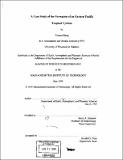| dc.contributor.advisor | Kerry A. Emanuel. | en_US |
| dc.contributor.author | Kung, Terence, 1974- | en_US |
| dc.contributor.other | Massachusetts Institute of Technology. Dept. of Earth, Atmospheric, and Planetary Sciences. | en_US |
| dc.date.accessioned | 2010-04-28T15:32:54Z | |
| dc.date.available | 2010-04-28T15:32:54Z | |
| dc.date.copyright | 1999 | en_US |
| dc.date.issued | 1999 | en_US |
| dc.identifier.uri | http://hdl.handle.net/1721.1/54440 | |
| dc.description | Thesis (S.M.)--Massachusetts Institute of Technology, Dept. of Earth, Atmospheric, and Planetary Sciences, 1999. | en_US |
| dc.description | Includes bibliographical references (p. 76-79). | en_US |
| dc.description.abstract | A case study is performed to investigate the nature of tropical cyclogenesis in the eastern Pacific Ocean. Focus is given to the formation and development of the initial circulation which eventually intensified into Hurricane Fefa. Using satellite imagery, the author studies the development of convective activity in the genesis region. Gridded reanalysis data are used to document the synoptic-scale flow, with emphasis on tracing the easterly wave which is associated with the formation of Fefa. The data show that the easterly wave propagated across the Caribbean Sea and the Central American mountains, and the initial circulation developed while the wave had moved into the eastern Pacific. The wave is found to have moved through an unstable basic state while it was in the Caribbean, which is favorble for its growth and maintenance. Two phenomena are observed prior to the formation of the low-level circulation. These include an easterly jet in the eastern Pacific that may have been associated with the blocking effect of the Central American mountains, and a southerly wind surge into the monsoon trough region. In addition, aircraft observations collected during Tropical Experiment in Mexico are used to study the evolution of the mesoscale system. Initially, a circulation in the middle troposphere with a cold core in the boundary layer, and a shear line located to the west were found. One day later, a low-level warm core vortex had developed, and it was displaced from the mid-level vortex. It is suggested that the low-level vortex formed from the spin-up of the monsoon trough, independent of the mid-level vortex. | en_US |
| dc.description.statementofresponsibility | by Terence Kung. | en_US |
| dc.format.extent | 79 p. | en_US |
| dc.language.iso | eng | en_US |
| dc.publisher | Massachusetts Institute of Technology | en_US |
| dc.rights | M.I.T. theses are protected by
copyright. They may be viewed from this source for any purpose, but
reproduction or distribution in any format is prohibited without written
permission. See provided URL for inquiries about permission. | en_US |
| dc.rights.uri | http://dspace.mit.edu/handle/1721.1/7582 | en_US |
| dc.subject | Earth, Atmospheric, and Planetary Sciences. | en_US |
| dc.title | A case study of the formation of an Eastern Pacific tropical cyclone | en_US |
| dc.title.alternative | case study of the formation of an Eastern Pacific hurricane | en_US |
| dc.type | Thesis | en_US |
| dc.description.degree | S.M. | en_US |
| dc.contributor.department | Massachusetts Institute of Technology. Department of Earth, Atmospheric, and Planetary Sciences | en_US |
| dc.identifier.oclc | 43876804 | en_US |
